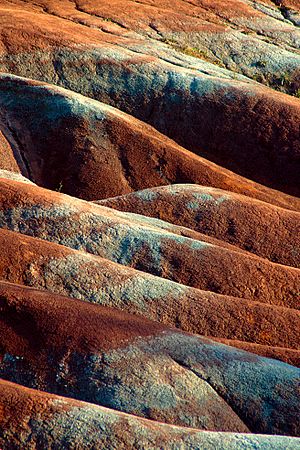Queenston Formation facts for kids
Quick facts for kids Queenston FormationStratigraphic range: Maysvillian to Richmondian |
|
|---|---|

Queenston Formation exposed at the Cheltenham Badlands
|
|
| Type | Geological formation |
| Underlies | Cataract Group and Clinton Formation |
| Overlies | Cincinnati Group/Georgian Bay Formation / Carlsbad Formation / Oswego Formation |
| Thickness | Up to 300 m (980 ft) |
| Lithology | |
| Primary | Shale |
| Other | Siltstone, sandstone, limestone, gypsum |
| Location | |
| Region | Ohio, Southern Ontario Western New York |
| Country | |
| Type section | |
| Named for | Queenston, Ontario |
| Named by | J. F. Caley |
| Year defined | 1940 |
The Queenston Formation is a special layer of rock that formed a very long time ago. It's from the Late Ordovician Period, which was about 450 million years ago! You can find this rock layer in Ontario, Canada, and in New York, United States.
This rock layer is part of something called the Queenston Delta. Imagine a huge pile of eroded bits of rock, like a giant fan. This "delta" formed because of a big mountain-building event called the Taconic Orogeny. The Queenston Formation is mostly made of red and grey shale, which is a type of soft, layered rock. It also has thinner layers of siltstone, limestone, and sandstone. In New York, you'll find more of the sandy layers.
Contents
What is the Queenston Formation?
The Queenston Formation is a thick, wide layer of rock. It's like a giant wedge, getting thinner as it stretches from southeast to northwest. It can be up to 300 meters (about 984 feet) thick under Lake Erie.
This rock layer is the very top layer from the Ordovician Period in Southern Ontario. Above it, you'll find younger rocks from the Silurian Period. Below it, the Queenston Formation gradually blends into older rock layers like the Georgian Bay Formation in Ontario or the Oswego Formation in New York.
What are the Queenston Rocks Made Of?
The Queenston Formation is mostly made of red and grey shale. These shales often contain hematite, which is an iron mineral that gives them their reddish color. The green parts of the rock are where the iron minerals have changed due to water.
You can also find thin layers of other rocks mixed in. These include sandy limestone and siltstone. In New York, these sandy layers are much thicker. Sometimes, you might even find small amounts of gypsum, which is a mineral that forms when water evaporates. On Manitoulin Island, the formation has more limestone and dolomite.
Ancient Life: Fossils in the Rocks
The Queenston Formation doesn't have a lot of fossils, especially in its top shale layers. But in some parts, you can find traces of ancient sea creatures! These include:
- Brachiopods (shellfish)
- Bryozoans (tiny colonial animals)
- Ostracods (small crustaceans)
- Bivalves (like clams)
- Gastropods (like snails)
- Tabulate corals (an extinct type of coral)
- Trilobites (ancient sea arthropods, like Acernaspis)
Even more common are trace fossils. These are not the animals themselves, but the marks they left behind, like burrows or tracks. Examples include Diplocraterion, Skolithos, and Chondrites.
How Did These Rocks Form?
Most of the rocks in the Queenston Formation were laid down in a warm, dry coastal area. Imagine a wide, muddy shoreline with shallow water. This area was affected by tides, frequent storms, and changing sea levels. The sea level changed because of Earth's moving plates (tectonics) or even a big ice age.
The mud often dried out in the sun, leaving behind mudcracks, just like you see in dried mud puddles today. Sometimes, when isolated pools of water evaporated, minerals like gypsum were left behind.
Scientists have identified 14 different types of rock layers, which they group into four main types. These types show that the rocks formed in different environments:
- Some formed on a shallow continental shelf, where storms could stir up sand.
- Others formed in areas where the water level changed a lot, from always underwater to sometimes dry.
- Some formed in coastal areas where land and sea met.
- In New York, some layers formed in braided rivers, where sand was carried by flowing water.
Today, you can find similar environments in places like the Gulf of California and the northwest coast of Australia.
What is the Queenston Formation Used For?
The Queenston Formation is important for a few reasons:
- In New York, some of the sandstone layers in the formation hold natural gas. People have been getting natural gas from these rocks since the 1940s! These layers are also being looked at for storing carbon dioxide underground to help the environment.
- In Ontario, the shale from the Queenston Formation has been used for a long time by companies that make ceramic products, like bricks and tiles.

